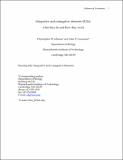Integrative and Conjugative Elements (ICEs): What They Do and How They Work
Author(s)
Johnson, Christopher M.; Grossman, Alan D.; Johnson, Christopher M; Grossman, Alan Davis
DownloadGrossman2.pdf (420.5Kb)
OPEN_ACCESS_POLICY
Open Access Policy
Creative Commons Attribution-Noncommercial-Share Alike
Terms of use
Metadata
Show full item recordAbstract
Horizontal gene transfer plays a major role in microbial evolution, allowing microbes to acquire new genes and phenotypes. Integrative and conjugative elements (ICEs, a.k.a. conjugative transposons) are modular mobile genetic elements integrated into a host genome and are passively propagated during chromosomal replication and cell division. Induction of ICE gene expression leads to excision, production of the conserved conjugation machinery (a type IV secretion system), and the potential to transfer DNA to appropriate recipients. ICEs typically contain cargo genes that are not usually related to the ICE life cycle and that confer phenotypes to host cells. We summarize the life cycle and discovery of ICEs, some of the regulatory mechanisms, and how the types of cargo have influenced our view of ICEs. We discuss how ICEs can acquire new cargo genes and describe challenges to the field and various perspectives on ICE biology.
Date issued
2015-10Department
Massachusetts Institute of Technology. Department of BiologyJournal
Annual Review of Genetics
Publisher
Annual Reviews
Citation
Johnson, Christopher M., and Alan D. Grossman. “Integrative and Conjugative Elements (ICEs): What They Do and How They Work.” Annual Review of Genetics 49.1 (2015): 577–601.
Version: Author's final manuscript
ISSN
0066-4197
1545-2948